
MORE MARS FORESTS & LAKES
Report #090
August 13, 2005
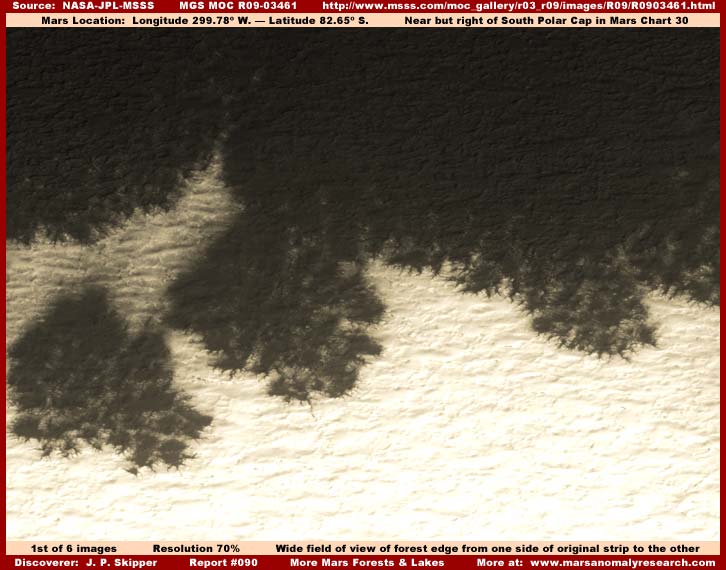
The science communities struggle so with the concept of liquid surface water and biological life as we are familiar with it on Mars. They intuitively suspect both are on Mars and can't quite let it go but at the same time believe it is quite impossible because the official foundation science data they've been fed tells them so. It is strange, naive and sadly pathetic that they cannot see what is right in front of their eyes in the visual data and so very obvious.
As an example, this is a combination report on forest and water evidence. The water evidence here is very much as we might expect it to be in our Earth experience. On the other hand, the forest evidence presented here will demonstrate strong differences as well as some similarities in comparison with our Earth experience and expectations.
The first part of this report starts off with the above first image from science data strip R09-03461 sampling of a forest of sorts as demonstrated by the dark areas. It qualifies as a forest because of its huge size, extensive coverage, carpeting density, spreading nature, and the simple fact that it is very much dynamic life rather than inanimate geology. The highly light reflective portion of the image of course represents terrain geology.
Because the dark mass life evidence here in my first three images is so dark and light absorbing and the very light color terrain is so bright and light reflective, it is difficult to strike a balance imaging detail wise between the two when trying to clarify these images from this strip. Too much lightening emphasis on the dark mass evidence revealing detail there creates way too much blinding white reflectivity washing out too much terrain detail. Alternatively too much emphasis on bringing out terrain detail wants to turn the already dark life evidence even darker obscuring important detail there. With the balance I've struck here, the key is to get your face closer to the computer screen to see slightly better surface texture detail in the dark life areas. But, the terrain detail is also important here too because it provides the context background on top of which the dark life form evidence exists and conforms in shape to. This relationship evidence helps determine the height and covering quality of the dark life and so it is desirable to preserve this visual evidence as well.
Now this first evidence isn't a forest as we normally think of one here on Earth as being full of different species of trees, bushes and plant life. This forest clearly consists of only one kind of life form species as noted by the lack of any visual evidence demonstrating any individual difference in shape and texture to the contrary. As you can see in the above visual evidence, it apparently advances and spreads by the establishment of multiple advance patches of itself on the forest's outer perimeter. These multiple patches then in turn spread 360º outward by what appears to be creeping and branching runners that then eventually fill in the terrain surface space around them and between the multiple patches. As you can also see by close examination in the inner dark solid dense area in the upper image, this life carpets and engulfs all open space eliminating any visual sign of the highly light reflective geological terrain evidence and leaving no chance for any other competing vegetation life form to establish itself within the merged mass.
Even so, I suspect that the presence of only one but clearly a flourishing form of life in visual evidence here is at least in part a function of the terrain itself. I suspect that this particular terrain may be hostile to most Mars life and the only one that can survive and flourish here is this specialized one that can adapt to this type of terrain and its chemical composition. Note that this life doesn't appear to be a very tall growing as might be the case with a typical Earth hard wood forest. Rather, it appears to be lower growing with a fine smoother and probably relatively soft surface texture like mold or moss that covers the terrain spreading out from these patches and generally conforming to the shape of the terrain that it covers.
In fact, except for scale, haven't we seen this look in a lab petri dish before? Think of it, we may actually be looking at a gigantic form of microbial bacteria collective colony life here like mold. If so, that would make this life unique and quite different relative to our Earth experience, at least scale wise.
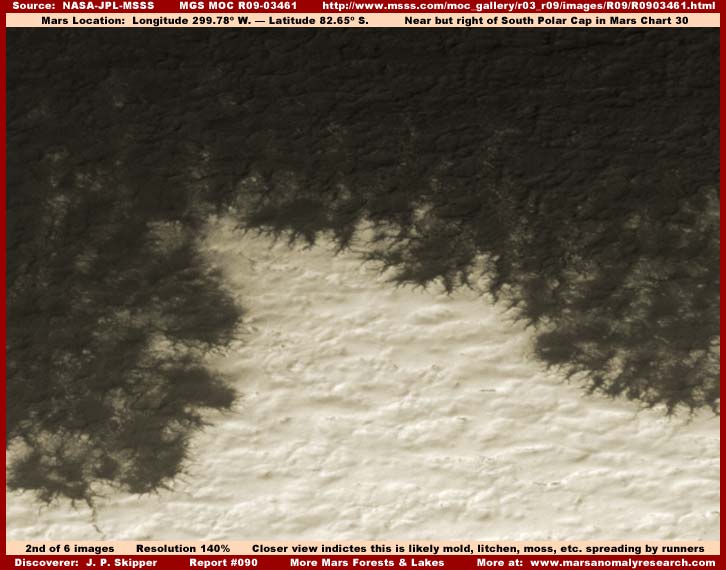
The above second image is a closer view of a section of the edge of this forest as seen in the above first image just before too much increased blur begins to be too much of a negative factor obscuring finer detail. Careful examination reveals that there may be smaller harder components within this dark mass and that soft texture mold life as a concept that we are most familiar with may not quite adequately define this life form but I suspect it does still come very close.
Note that, although the general geological terrain is highly light reflective, no portion of the dark life mass has any light reflectivity at all. This tends to indicate that this life form is very small and fine textured in its great many component parts creating a porous surface texture of some depth absorbing light rather than reflecting it while at the same time being very large in its overall spreading mass. The relatively small file size of these R09-03461 strip based images tends to support such an assessment. The overall dark dull coloration is also no doubt a solar energy absorbing strategy and it is possible that this is a collective colony form of life similar to those brought to attention in some of my previous reports.
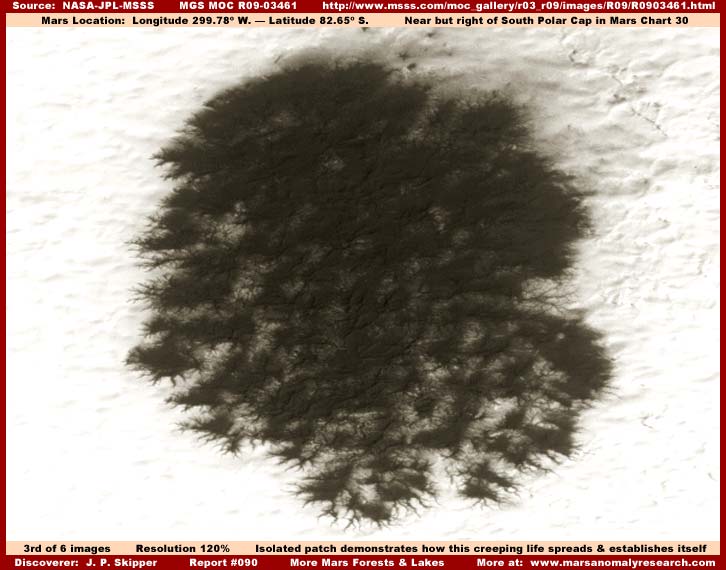
The above third image is of a isolated patch sitting alone like an island by itself lower down in the same science data strip. I've included it here because it shows the entire dark mass interior as well as its perimeter edge evidence quite well as compared to the much more massive forest areas with its broad boundary edges and solid carpeting interiors. Note that interior area light reflective ground geology is demonstrated in a few places within this mass and has not yet quite been engulfed and completely covered over. Obviously, this particular area isn't as well established (newer?) as the much larger and denser forest areas above this location.
Before leaving this particular type of massed Mars forest evidence, I want you to take a look at the R09-03461 narrow-angle strip's companion R09-03462 wide-angle context image strip on the right on the page that will open. Note there the small white outline of the narrow-angle strip location within the wide-angle strip on the bordering edge of the extensively larger dark mass and its size. This will give you a good sense of the true size scale of the dark area forest in evidence here covering a very large hunk of terrain. That's a lot of territory for just one type of life form to cover and especially if this is some life we normally associate with a small petri dish scale wise here on Earth.

The above fourth image from a different science data strip R07-01100 demonstrates liquid surface water lake evidence. I've included this type of evidence because of course liquid (as differentiated from solid form ice) surface water and life as we may be familiar with it go hand in hand. Remember, the presence of liquid surface water conditions has the potential to enable the presence of such life.
These are clearly two well defined depressions in the ground and just as clearly are filled with a liquid. The flat self leveling quality so characteristic of liquid is clearly demonstrated by a faintly seen narrow band highly reflective shore around the lake perimeter edge and a irregular waterline butting up against the narrow-band sloped shore as pointed out by my arrows and labels in the above image. If you will examine this very closely, you can also see some faint liquid surface reflectivity as well. You should also be aware that there is another smaller water depression nearby to the upper right of these two sites in the strip but I elected not to image it here in this report as it is just redundant information.
Note that the interior contents of these two depressions are a very light and very bright color. One might assume that this may be because of the presence of highly reflective ice conditions. Such an assumption would conveniently in turn enable the perception and following arguments that this ice is probably CO2 ice. However that just isn't the case here. Note that the flat level interior surface and the obvious narrow band of sloped bare shore between the true liquid waterline and the darker background shore as pointed out by my labeling are both very light color. In my opinion, this is because of an application of light color semitransparent (opaque) smudge image tampering was mapped and applied equally to both the bare sloped shore narrow band and the flat water surface together.
Now, if it had been applied thick enough in enough layers, the evidence of flat level liquid waterline as differentiated from the narrow band of sloped shore evidence would have been merged together and eliminated. That is typical of how effectively obscuring water sites goes in this planetary Mars imaging as it has been released to us. Fortunately for us liquid water depth because of its transparency absorbs more light than it reflects and is normally a darker color preserving the water here as a very slightly darker color and thereby the faintly seen waterline demarcation line effect is preserved. Also, the narrow band of reflective sloped shore as above water terrain was already a lighter reflective color in the natural sunlight. So the tampering application made it even lighter maintaining to some extent the contrast difference between the water and narrow band of sloped shore to preserve the irregular waterline demarcation line.
This type of tampering is typical of how the visuals of the natural visual qualities of liquid surface water are hidden from view in the Mars satellite science data imaging. I have seen a great many much more effective applications, especially around and on the South Polar Cap itself. Most of the time these applications are successful at merging the water and shore into a false single flattened visual effect intended to and relatively effectively mimicking an ice field, at least as it appears in the compromised quality distant satellite imaging as released to us. Remember, if it can be made to appear to be solid form ice, then it can in turn be argued that it is CO2 ice rather than water ice. At the very least, doubt is introduced and, when in doubt, who are you going to believe a lone individual like me or the whole scientific world?
An example of the more effective, if not completely effective, use of such very similar liquid surface water lake image tampering application can be seen in my Report #086 titled "" and specifically the closer view fourth image there. There the application layers are thick enough to merge and visually eliminate the water to shore demarcation line. The same type of evidence can again be seen, but much more effectively hidden, in my Report #026 titled "Dissecting A Water Find: Part #3." Also again in my Report #037 titled "More South Polar Cap Civilization Evidence" in image #3, both demonstrating lake evidence.
Fortunately for us, natural liquid water transparency and thereby its color tint varies from site to site and even at the same site when viewed at different times of the day and solar light angle not to mention weather conditions and camera angle. So it is not easy to always get the image tampering application thickness just right. That is the case here where the image tampering application layers are just a little too lightly done to complete the process of obscuring the waterline as differentiated from the narrow band shoreline evidence. Both can still be faintly seen. The bright light color obscures much but not quite enough.
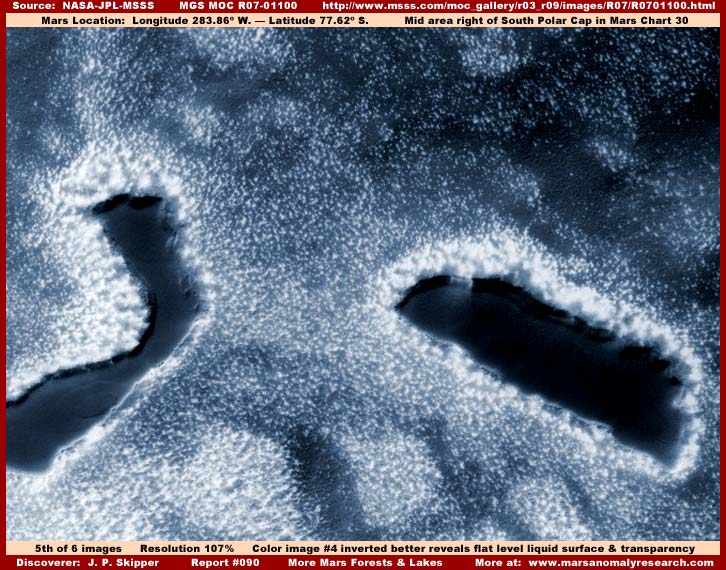
The above fifth image is actually just the fourth image inverted and without my labeling. The one thing that it does best is plainly reveal the presence of the flat level liquid surface in these two depression as well as a bit of the liquid transparency and reflectivity factors and of course the irregular shoreline/waterline created by the liquid. Here in this inverted image, the narrow band sloped shore appears as literally black and the water a not quite so dark in color. Remember, as I have previously reported, CO2 has solid (ice) and gas (vapor) physical states but no liquid state in open environs where expansion is possible. That means that, if you are satisfied that a liquid exists here in these two depressions, then the liquid evidence clearly cannot be CO2 because it has no such physical state.
That essentially leaves liquid surface water as the logical alternative. If it walks like a duck and quacks like a duck, then it is probably a duck. In other words, simple observational logic and an open mind is all that is required here, not rocket science. Note the look of these depressions. Note their flat level inner areas demonstrating irregular shorelines/waterlines. Although the distance is too great and such smaller evidence is too fuzzy resolution wise, note in the previous fourth image what appears likely to be dark vegetation of some kind clustering more thickly immediately around the depression's outer perimeters and thinning out quickly as it gets further away from the depressions. This is just as vegetation often behaves in our Earth experience around surface water sites.
Look familiar to you? It certainly does to me. In fact, this is so obvious that there really is no need for me to belabor the point further and so I'll move on.
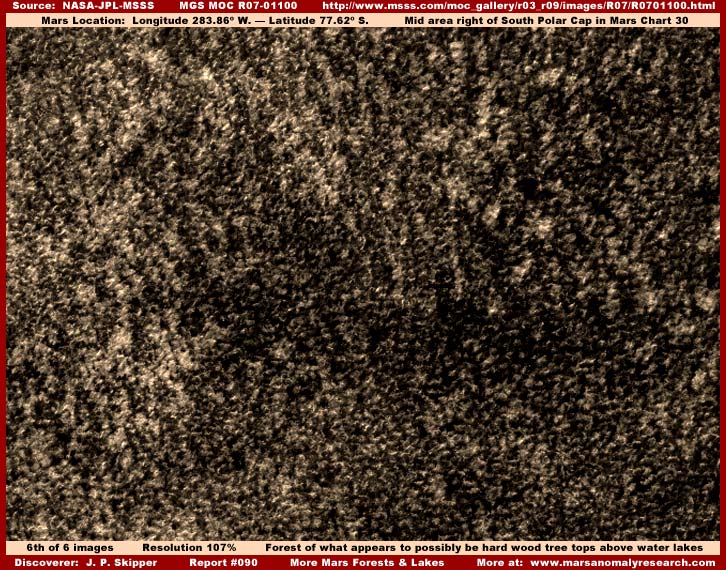
There's one more piece of evidence. The above sixth image is from the same strip as the water lakes evidence. Does anything in this image look like bare geological terrain to you? Don't see any geology down there? That's because there isn't any visible to see. What we are looking at here is something so dense and tightly packed that it has covered over and completely blotted out the much more light reflective terrain visual evidence.
If in doubt and if you really want to know what the geological terrain in this locale looks like, you only have to look in the original science data strip R07-01100 from which this forest and water lakes evidence is drawn. As you view moving down this long strip from top to bottom you will see what a mixture of scattered vegetation as well as what true higher reflectivity geological terrain looks like. Then, as you continue to move further down the strip, you will encounter this very dark area of the super dense vegetation, a section of which you see in the above sixth image. It's about 70% of the way down the strip. At the very bottom of the strip, you will find the water lakes evidence reported in my fifth image here including a smaller lake that I did not report on and image.
As you can see, what ever this is in the above sixth image, it carpets and completely covers this particular section of terrain allowing no view of the true more highly light reflective geological terrain under it. I think that there is no question that this evidence represents aggressive healthy competing life of some kind and almost certainly that life is vegetation forest very probably more typical of our Earth experience. What we are looking at is a great many individual objects down there. Further, the abnormally large file size of this particular image confirms that the graphics software is counting a great many individual objects down there.
So, although the forest evidence is very tightly packed tending to merge together into a great visual mass, it is definitely constituted by a great many fairly large individual objects with a appearance very much like tall trees tops as seen straight down from above. Note that there are different colors and shapes with differing light reflectivity qualities all mixed up in this mass, again very much like a Earth hard wood forest of trees of differing species and growth heights. For a look at similar fairly comparable Earth hard wood forest tops visual evidence as seen from above at different angles, go to my Report #086 titled "" and image #3 there not to mention the whole report itself.
Compare the very likely tree evidence seen here in the above sixth image and that in Report #086 as well as others I've reported on with the forest evidence at the beginning of this report demonstrating the difference in types. The variety of the evidence indicates there are vegetation similarities between Mars and Earth but also some dramatic differences to, such as the evidence in the first part of this report, perhaps due to the differences in gravity, environment and history or even the accumulative impact of civilizations past and/or present.
In the first part of this report, what appears on the surface at first glance to be Mars vegetation may well be giant form mold colony, microbial, bacterial life rather than the type of biological vegetation plant life we are used to here on Earth. Take a look at another variation of this in my Report #087 titled "Mars South Polar Geysers are Life" on colony life. Even when it comes to true vegetation life in the form of plants and/or trees, take a look at my Report #019 titled "Giant Plant Species Found on Mars" demonstrating what appears to be colossal in size branching trees looking very much like gigantic palms as seen from above but far far larger than any tree found on Earth and which just may be incredibly ancient.
Remember, heavy CO2 conditions in general actually favor the kind of vegetation plant life we are familiar with here on Earth. Plant life of course utilizes CO2 and produces oxygen as their waste byproduct and the reverse is true of animal life striking the balance in Earth's atmosphere we are familiar with. The presence of old well established extensive forests on Mars as well as liquid surface water (H2O) would logically imply the likely presence of significantly more oxygen in the Mars atmosphere than officially reported. Has someone been manipulating this underlying key foundation science data that the science community uses so extensively?
Truly, in many ways Mars does appear to be a place of extremes in some of its aspects relative to our Earth experience. The official interpretation would have us believe that such extremes mostly take the form of a hostile environment consisting of hard freezing conditions, little to no water, no life, and a primarily a CO2 atmosphere hostile to Earth humans and most animal life as we know it. In other words, a world interesting only to scientists and/or academics and no need for you and I to be otherwise too concerned with it. As time goes by, you and I can trust our leadership to tell us what we need to know (aka what they want us to know) along and along as they deem fit to disseminate such information to us.
However, the growing discovery evidence record here increasingly indicates Mars may very well have a fair amount of liquid surface water including even very extensive South Polar seasonal liquid flood waters. This raises all kinds of questions as to the correctness of the officially reported Mars surface and atmospheric conditions foundation data. For example, the mere presence of liquid surface water seriously encourages the consideration of the possibility of life taking advantage of it. Further, the discovery evidence record here also demonstrates the presence of a variety of such life including both biological life as well as technologically advanced intelligent life.
It is a unfolding or unraveling story, depending on your point of view, of incredible dimension and implications. Just how long can this growing evidence and its implications be ignored?
DOCUMENTATION
http://www.msss.com/moc_gallery/r03_r09/images/R09/R0903461.html: This link will take you to the R09-03461 official science data imaging that is the source of my 1-3 images in this report. While there please note the companion wide-angle R09-03462 image to see how extensive the dark color life evidence is in the wider context view.
http://www.msss.com/moc_gallery/r03_r09/images/R07/R0701100.html: This link will take you to the R07-01100 official science data imaging that is the source of my 4-6 images in this report. While there please note the companion wide-angle R07-01101 image but only to note the medium color obscuring dithering smudge over most of the upper part of this image obscuring the true terrain.
, Investigator
![]()